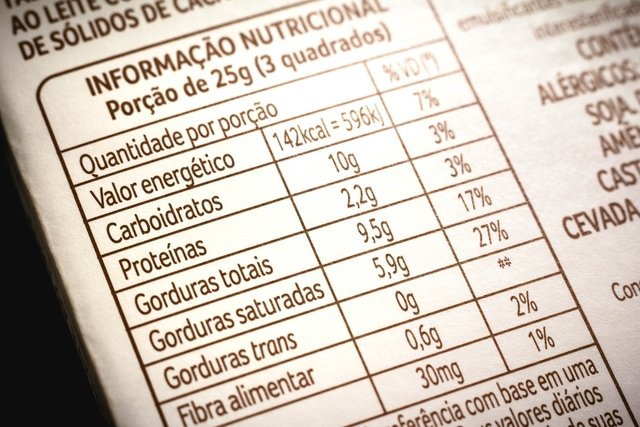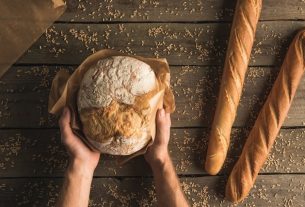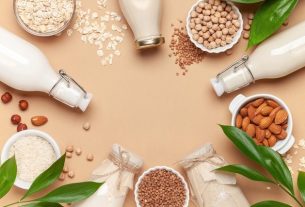Food labels are tables that contain information about the amounts and types of nutrients present in foods and products, such as carbohydrates, proteins and vitamins, in addition to including a list of all the ingredients that are used in the manufacture of the products.
Knowing how to read food labels makes decisions easier when choosing a product, helping to maintain a balanced diet, because it allows you to compare the quantity and quality of nutrients and know whether a product is healthy or not.
Food labels must inform the amounts of calories, total fat, and whether they contain allergenic ingredients such as gluten, lactose, soy or almonds, for example. This way, it is possible to avoid products that can cause health problems, such as diabetes, obesity, high blood pressure or gluten allergies.

The following list contains the information that must appear on food labels:
Nutritional information
Nutritional information must be indicated within a table, which must be located close to the list of ingredients and where it is possible to check the product portion, calories, amount of carbohydrates, proteins, fats, fiber, salt and other nutrients, such as sugar, vitamins and minerals.
1. Portion
The portion is the average amount of food that a healthy adult should consume. This measurement is standardized to facilitate consumer understanding and comparison with other similar products.
The total number of portions per package of the product must be informed, as well as the individual portions, which must contain the quantity both in grams or ml, and in homemade measurements, for example: in 1 package of sliced bread with 20 slices and total weight of 400g, the number of portions per package would be 10 and the portion would be 40g (2 slices).
Food labels must contain the amount of nutrients for each portion of the food and for each 100g or 100 ml. This information is important, because some labels that say they have only 50 calories mean that there are only 50 calories in a 100g portion. However, if the package contains 200g of product, it means that you will be consuming a total of 100 calories, for example
2. Calories
Calories are the amount of energy that carbohydrates, proteins and fats in food provide to the body. Each food group provides a certain amount of calories to the body: 1 gram of carbohydrate provides 4 calories, 1 gram of protein provides 4 calories and 1 gram of fat provides 9 calories.
On food labels, calories are reported in kilocalories (Kcal) and kilojoules (Kj). The daily calorie recommendation for a healthy person is 2000 Kcal. Food labels must inform the amount of calories for each 100g or 100ml and for each portion per food package.
3. Carbohydrates
Carbohydrates provide energy for the body, especially the brain. The recommended intake for a healthy adult is 300g of carbohydrates per day, which can be found mainly in foods such as rice, potatoes, bread, cassava, sugar, honey, yams and sweets. See a list of foods that are sources of carbohydrates.
Food labels must contain the amount of total carbohydrates, total sugars and added sugars for each portion per package and for each 100g or 100ml of food.
4. Proteins
Proteins are necessary for the production of hormones and for the development and maintenance of the health of organs such as the heart, lungs and skin. Discover other health benefits of proteins.
Proteins are found in good quantities in foods of animal origin, such as eggs, fish, chicken, milk and dairy products, and of vegetable origin, such as beans, soybeans, lentils and peas. The recommended amount of consumption for healthy adults is 75g of protein per day.
The amount of protein in products must be reported for each 100g or 100ml and for each portion per food package.
5. Total fats
Total fat is the sum of all types of fat in products, including saturated fat, trans fat and polyunsaturated fat, and the recommended consumption of this nutrient for healthy adults is 55 g per day.
Fat is the main source of energy for the body, as well as being necessary for the absorption of vitamins and the production of hormones. Some of the foods that are sources of fat are those of vegetable origin, such as olive oil, coconut oil and canola oil, chestnuts, walnuts and almonds, and those of animal origin, found in salmon, milk and dairy products and chicken, for example.
Food labels must inform the amount of total fat, saturated fat and trans fat for each portion per package and for each 100g or 100ml of food.
6. Saturated fats
Saturated fats represent a part of total fats and are found mainly in foods of animal origin, such as butter, milk and dairy products, meat, chicken and eggs. Discover other foods rich in saturated fat.
The recommendation for saturated fat is up to 10% of the total caloric value of the diet. On an 1800 calorie diet, it is recommended to consume up to 20 g of saturated fat per day, which is equivalent to approximately 200 g of grilled picanha, for example.
7. Trans fats
Trans fat is only found in processed foods, such as margarine, hydrogenated fat, cookies, ice cream, cakes and pies that use hydrogenated fats in their preparation.
The consumption of trans fat should be avoided, as it can contribute to the emergence of diseases such as cancer, diabetes and cardiovascular disease. The maximum recommended intake of trans fat is up to 1% of the total caloric value of the diet. On a 2000 calorie diet, the recommended amount of trans fats is up to 2g per day, for example.
8. Fibras
Fibers are nutrients found in fruits, vegetables, legumes and cereals that help maintain good bowel function, in addition to balancing blood sugar and cholesterol levels and controlling hunger. The recommended fiber intake for healthy adults is 25g per day. Discover the main foods rich in fiber and their benefits.
The amount of fiber in products must be reported for each 100g or 100ml and for each portion per food package.
9. Sodium
Sodium is a mineral present in table salt, but it can also be added to many processed foods, such as cookies, ice cream, cakes, bread, pizza, preserves and ready-made sauces. See other foods that contain sodium.
Sodium intake for a healthy adult should not exceed 2400 mg per day. The amount of sodium in products must be reported for each 100g or 100ml and for each portion per food package.
10. Other nutrients
Information on food labels regarding minerals such as calcium, iron and potassium, other vitamins such as vitamin A and C, and cholesterol is considered optional.
Despite being optional information, the National Health Surveillance Agency suggests that manufacturers inform on the nutritional label whenever calcium, iron and cholesterol values are equal to or above 5% of the recommended daily intake.
11. Daily value
The daily value is represented as %VD and indicates the percentage of nutrients that should be consumed per day to maintain a healthy diet and is based on a diet of 2000 calories per day.
If a 20g portion of bread indicates that it has a %DV of 10% sugar, it means that 1 portion of this product provides 10% of the total sugar that should be consumed per day on a 2000 calorie diet, for example.
To maintain a healthy and balanced diet, it is important to prioritize products with a low %VD for saturated fats, trans fats and sodium and products with a high %VD for dietary fiber.
List of ingredients
The list of ingredients informs the components present in the product and must be in descending order, that is, the ingredients that are in greater quantity are at the front and those that are in smaller quantity at the end of the list.
Reading the list of ingredients on food labels makes it easier to see additives, such as sugar, colorings, preservatives and sweeteners used in processed products and which often appear with strange names or numbers.
In the case of sugar, it can be found under different names, such as corn syrup, fructose, invert sugar, concentrated fruit juice, maltose, dextrose, glucose, sucrose and honey, for example.
Front nutrition labeling
Front labeling must appear on the packaging of all foods high in added sugar, saturated fat or sodium. This type of labeling is represented by the design of a magnifying glass, which must be located on the front and top of the packaging.
Warnings on front labeling must be reported whenever foods exceed the following recommendations:
- Added sugar: it must contain a front warning whenever the product contains 15 g or more per 100 g of solid food, or 7.5 g or more per 100 ml of liquid food;
- Saturated fat: must have a front warning if the product contains 6g or more for every 100g of solid food, or 3g or more for every 100ml of liquid food;
- Sodium: You should be alerted whenever the product contains 600 mg or more for every 100 g of solid food, or 300 mg or more for every 100 ml of liquid food.
The objective of front labeling is to simplify nutritional information to help consumers choose healthier products.
How to choose products
The following table contains the recommended amount for each nutrient to help you choose products:
Food additives
Food additives are ingredients that can be added to products to maintain or improve their safety, freshness, flavor, texture or appearance or extend their shelf life. Learn more about food additives.
The most commonly used food additives include:
1. Dyes
The main types of artificial coloring that can be used in foods are: yellow nº 5 or tartrazine (INS 102), yellow nº 6, and twilight yellow or sunset yellow (INS 110).
In the case of artificial colorings, there is some concern about their consumption, as they have been linked to allergies in some people, and in these cases it is recommended to avoid foods that contain them. Understand better what an allergy to dyes is.
One option to replace artificial colorings is to choose products with natural colorings, such as paprika or red paprika (INS 160c), turmeric (INS 100), betanin or beetroot powder (INS 162), lycopene (INS 160d), anthocyanins (INS 163 ), saffron and chlorophyllin (INS 140).
2. Sweeteners
Sweeteners, or sweeteners, are substances used to replace sugar and can be found under the names of acesulfame K, aspartame, saccharin, sorbitol and sucralose.
Stevia is a natural sweetener obtained from the Stevia Rebaudiana Bertonies plant, which can be a good alternative to artificial sweeteners.
3. Preservatives
Preservatives are substances that can be added to food to prevent it from spoiling when it comes into contact with bacteria and fungi, for example. However, preservatives can cause allergic reactions in some people with asthma and allergies, hives or headaches.
Among the best-known preservatives are nitrates and nitrites, which are mainly used to preserve and salt smoked meats and sausages. Other lesser-known preservatives are sulfites, antioxidants that are normally added to wines to preserve the drink.
How to compare food labels
To compare food labels, the nutritional information must be evaluated for the same quantity of each product. For example, if the labels of 2 types of bread have nutritional information for a 50 g portion, then it is possible to compare the two without having to make further calculations. However, if the label of one bread has information for 50 g and another provides data for 100 g of bread, then it is necessary to calculate the proportion to adequately compare the two products.
Another simple and faster way to compare products is using the front nutritional labeling, which allows you to check the amount of sugar, saturated fat and sodium present in the food.
Learn more about how to read food labels in the following video:

Sign up for our newsletter and stay up to date with exclusive news
that can transform your routine!
Warning: Undefined array key "title" in /home/storelat/public_html/wp-content/plugins/link-whisper-premium/templates/frontend/related-posts.php on line 12
Warning: Undefined array key "title_tag" in /home/storelat/public_html/wp-content/plugins/link-whisper-premium/templates/frontend/related-posts.php on line 13



